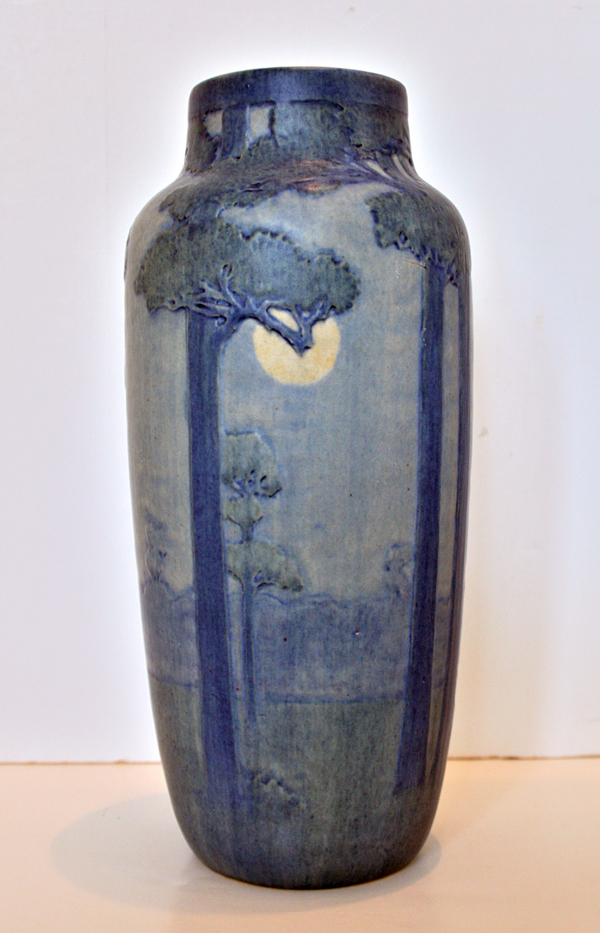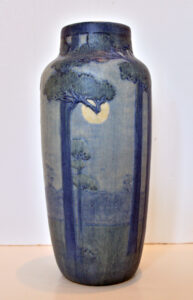Joseph Fortune Meyer
Master potter Joseph Fortune Meyer's classic shapes and consistently high standards are, most likely, the reason that Newcomb College art pottery became internationally famous

Courtesy of Jean Bragg Gallery.
A color photograph depicting a 1918 Newcomb College matte glaze vase by Joseph Fortune Meyer and Sadie Irvine.
Noted potter and historian Paul Harvey Cox, in his seminal series of articles on Gulf Coast pottery published in Ceramic Age in April 1935, stated that Joseph Meyer was the foundation of all art pottery on the Gulf Coast. Not only was Meyer the master thrower for Newcomb College Art Pottery during what art historians consider the studio’s most creative and productive period, he taught the eccentric Biloxi potter George Ohr and also advised the young Peter Anderson about the development of Shearwater Pottery in Ocean Springs, Mississippi. Ohr and Anderson went on to become some of the most venerated potters of their time.
Early Years
Coming from a long line of earthenware potters, Joseph Fortune Meyer was born on February 18, 1848, in Buthiers, Haute-Saône, France. That year his father, Francois, immigrated alone, first to Pittsburgh, Pennsylvania, and then to New Orleans, finding work as a thrower in the William Virgin Pottery. In 1857, Francois brought his family from France to settle in Biloxi, Mississippi, a popular summer retreat and vacation home for many New Orleanians. During the Civil War Francois came to New Orleans to manufacture utilitarian redware from local clay, which he sold in the French Market. Not long after, in 1862, Joseph came to the city to work with his father. The elder Meyer died in 1870.
New Orleans Art Pottery
In 1879, Joseph Meyer invited his Biloxi, Mississippi, neighbor George Ohr to learn the earthenware trade in New Orleans for two years, after which the young Ohr traveled around the country visiting potteries. In 1886, Meyer was contacted by Tulane University artist and art educator William Woodward to build a ceramic facility for the New Orleans Art Pottery, the forerunner of Newcomb Art Pottery. To help him throw the pots for the female students to decorate, Meyer enlisted the aid of his former student, George Ohr, who was at the Baronne Street Pottery in 1888. Ohr assisted but returned to Biloxi by 1890. At this early stage, pots from the New Orleans Pottery featured traditional shapes, vivid colors, and a penchant for botanical motifs, resembling late nineteenth-century majolica. The flourishing pottery produced molded as well as thrown art pieces and also functional ware such as flowerpots.
Newcomb College Art Pottery
In 1896 Meyer was the third potter hired at Newcomb Art Pottery. Newcomb potters were always men and the designers were always women. It was in large part due to Meyer’s classic shapes and consistently high standards that Newcomb pottery became internationally famous. He elevated the pottery to its first international success, winning the bronze medal at the Paris International Exposition of 1900. In addition to throwing and glazing the pots for women to decorate, Meyer frequently experimented with glazes. He believed he rediscovered the copper red glaze known to the “ancient Egyptians.” He perfected other metallic and iridescent glazes, as well as a similar gunmetal glaze, which George Ohr subsequently popularized. Meyer formulated a matte blue glaze long before Paul Harvey Cox introduced this glaze to replace the traditional high-gloss finish in the classic Newcomb ware of 1910.
Honors and Awards
As an artist in his own right, Meyer entered his pottery into international fairs that were popular in the early twentieth century. He received a silver medal at the Pan-American Exposition in Buffalo, New York, and then at the 1904 Louisiana Purchase Centennial Exposition in St. Louis. For the latter he exhibited what he termed “fire-decorated” vases in his own experimental glazes. These were heralded as the art pottery of the future and stood in striking contrast to the traditional vases of Newcomb College, which were slip-painted or incised with southern botanical motifs. Meyer also exhibited at the 1915 Panama-Pacific International Exposition in San Francisco, California, where the Newcomb College Art Pottery took grand prize.
In 1910, Paul Harvey Cox was hired to assist Meyer at Newcomb College Pottery because of the latter’s failing eyesight. Cox was the first in a line of assistants, most of them chemical engineers educated at the New College of Ceramics at Alfred University in New York. Cox resigned from Newcomb in 1918 to serve in the military, but Meyer still continued to throw unerringly until 1927, when he retired.
Meyer’s pottery legacy continued after his retirement. In 1928, the Shearwater Pottery opened in Ocean Springs, Mississippi. It was run by the three sons of Annette McConnell Anderson, who knew Meyer when she studied pottery at Newcomb. After the Anderson family moved to Ocean Springs in 1922, Peter Anderson, the young potter, had the good fortune to have Meyer advise him in his new endeavor.
Meyer’s wife, Felicie, died in 1920. He spent the rest of his life with his adopted daughter, Mrs. James E. Walther, in New Orleans, where he died on March 16, 1931. His remains were interred at the Old Biloxi Cemetery in Mississippi near his lifelong friend, George Ohr.
Meyer’s work from the New Orleans Art Pottery and Newcomb College Art School can be found in the Louisiana State Museum in New Orleans, the Historic New Orleans Collection, the New Orleans Museum of Art, and the Woldenburg Art Center at Newcomb College on the Tulane campus.
